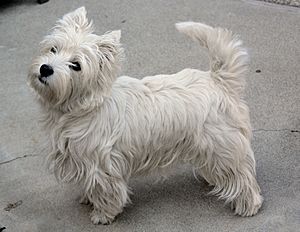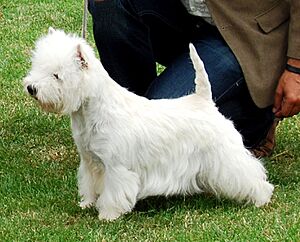West Highland White Terrier facts for kids
 |
|||||||||||||||||||||||||||||
| Other names |
|
||||||||||||||||||||||||||||
|---|---|---|---|---|---|---|---|---|---|---|---|---|---|---|---|---|---|---|---|---|---|---|---|---|---|---|---|---|---|
| Common nicknames |
|
||||||||||||||||||||||||||||
| Origin | Scotland | ||||||||||||||||||||||||||||
|
|||||||||||||||||||||||||||||
|
|||||||||||||||||||||||||||||
| Domestic dog (Canis lupus familiaris) | |||||||||||||||||||||||||||||
The West Highland White Terrier, often called a Westie, is a type of dog from Scotland. It has a special white coat that feels rough on the outside and soft underneath. Westies are medium-sized terriers. They have longer legs than some other Scottish terriers. Their fluffy white fur makes their face look round.
Westies are smart and learn quickly. They can be good with children, but they don't like rough play. They are energetic, playful, and friendly dogs. Westies were first bred to hunt small animals like rodents on farms. They need about an hour of exercise every day. The Westie breed we know today comes from white terriers bred in Scotland long ago. Edward Donald Malcolm is often given credit for creating the modern Westie.
Other related breeds include the Roseneath Terrier and Pittenweem Terriers. The Westie got its modern name in 1908. Major dog clubs started to recognize the breed around the same time. Westies are still very popular in the United Kingdom. They have won many awards at dog shows like Cruft's. In the United States, they have been among the most popular breeds since the 1960s. Westies can have some health issues. One condition in young dogs is called "Westie jaw." This causes extra bone growth in their jaw. They can also get skin problems.
Contents
What Does a Westie Look Like?
Westies usually have bright, dark eyes that are shaped like almonds. Their ears stand up and are pointed. Most Westies weigh between 15 and 20 pounds (6.8 and 9.1 kg). They are about 10–11 inches (25–28 cm) tall at the shoulder. Their body should be shorter than their height.
Westies have a deep chest and strong legs. They have a black nose and a short jaw. Their teeth meet in a "scissors" bite. This means their upper front teeth slightly overlap their lower front teeth. Their paws turn out a little. This helps them grip better on rocky ground. Young puppies have pink noses and paw pads. These slowly turn black as they grow up. Westies also have short, strong tails. Some people believe their tails were bred to be thick. This way, if a Westie got stuck in a hole while hunting, its owner could pull it out by the tail.
Westies have a rough outer coat that can grow to about 2 inches (5.1 cm) long. They also have a soft, thick undercoat. The fur around their face makes it look round. As puppies grow, their rough outer coat is often removed. This is done by "hand-stripping" (pulling out old hair) or clipping. Most Westies are pure white. Some can be a light cream color.
Westie Personality and Behavior
Westies can have different personalities. Some are very friendly with children. Others prefer to be left alone. They usually don't like rough handling. For example, they don't like it if a child pulls their ears or fur. They can also be protective of their food and toys. Because of this, it's important to train them when they are young. Westies can be good watchdogs. They are usually independent, sure of themselves, and confident. They are loyal and form strong bonds with their owners.
Westies are often busy and need at least an hour of exercise daily. They are very social dogs. They are known to be the friendliest of all the Scottish terriers. Westies are a tough breed. They can be stubborn, which might make training a bit tricky. Sometimes, their training needs to be refreshed. Like most terriers, they love to chase toys, especially balls. They have natural instincts to bark and dig holes. This comes from their history as "earthdogs" (dogs that hunt underground). In a book called The Intelligence of Dogs, Westies are ranked as having "average working/obedience intelligence."
Westie Health and Wellness
Westies usually live for about 12 to 18 years. A study in France found their average life expectancy to be about 12.93 years. A British study found it to be 13.4 years. A typical Westie litter has three to five puppies.
Westies can get some common health problems. These include abdominal hernias. Young Westie puppies might get a disease called craniomandibular osteopathy. This is also known as "lion jaw" or "Westie jaw." This disease is genetic. A puppy can only get it if both parents carry the faulty gene. It affects many breeds, not just Westies. It usually appears in dogs under one year old. It can make it hard for them to chew or swallow food. Vets can use X-rays to diagnose it. The bones around the jaw thicken. The condition often stops getting worse by the time the dog is one year old. Sometimes, it even gets better. It's usually treated with medicine to reduce swelling and by feeding soft foods.
Westies are prone to skin problems. About one-quarter of Westies get atopic dermatitis. This is a long-term allergic skin condition that can be passed down. More male Westies get it than females. A rare but serious skin condition called hyperplastic dermatosis can affect Westies of any age. Dogs with this condition can have red skin, dark patches, thick skin, and hair loss. At first, it might be mistaken for an allergy.
Another genetic problem in Westies is globoid cell leukodystrophy. This is a brain disease. Dogs with it lack a certain enzyme. Symptoms appear as the puppy grows, usually by 30 weeks of age. Affected dogs may have tremors, weak muscles, and trouble walking. The symptoms get worse over time, leading to paralysis. Because it's genetic, affected dogs should not be bred.
Westies can also get "white dog shaker syndrome." This condition causes tremors in the head and limbs. It was first thought to be linked to white coats. However, it has since been found in other breeds too. The condition usually develops quickly, over one to three days.
Less common conditions include hydroxyglutaric aciduria. This causes high levels of a certain acid in the dog's body fluids. It can lead to seizures and muscle stiffness. Westies can also get Legg–Calvé–Perthes syndrome. This is a problem with the hip joint. However, it's more common in other breeds. Westies are also less likely to have a luxating patella. This is when the kneecap slips out of place.
A specific skin condition called hyperplastic dermatosis of the West Highland White Terrier is only found in Westies. It's a severe, long-term skin disease. It's believed to be inherited. Symptoms include hair loss, redness, thick skin, dark skin, bad odor, ear infections, and itching.
A study in 2021 found that Westies are more likely to get chronic hepatitis (a liver problem). They are also more likely to have liver cell death. This can be caused by toxins or sudden liver failure.
Westie History: Where Did They Come From?
White Scottish terriers were first written about a very long time ago. This was during the reign of King James VI of Scotland (1567-1625). The king even ordered a dozen white terriers as a gift for the Kingdom of France. At the time, sandy or brown dogs were thought to be stronger than white ones. White dogs were sometimes seen as weak. For a while, the Westie was thought to be a white version of the Scottish Terrier or the Cairn Terrier.
In 1588, a Spanish ship crashed on the island of Skye. Reports said the ship carried white Spanish dogs. Their descendants were kept separate by the Clan Donald. Other families on Skye also kept white and sandy-colored dogs. The Clan MacLeod was one such family. Their descendants said that at least two of their chiefs owned white terriers.
George Campbell, 8th Duke of Argyll, bred a type of white Scottish terrier called the "Roseneath Terrier." Another white Scottish terrier breed appeared around this time. Dr. Americ Edwin Flaxman from Fife developed his "Pittenweem Terriers." He started with a female Scottish Terrier that kept having white puppies. He decided to focus on breeding white Scottish Terriers. He wanted them to be as respected as the darker-colored terriers. Dr. Flaxman is credited with helping to add classes for white Scottish Terriers at dog shows in the late 1800s.
The person most linked to the modern Westie breed is Edward Donald Malcolm. He owned terriers for hunting. The story goes that one of his reddish-brown terriers was mistaken for a fox and shot. After this, Malcolm decided to breed white terriers. These became known as "Poltalloch Terriers." The first Poltallochs had sandy coats. They already had ears that stood up, a trait seen in modern Westies. It's not known if Poltalloch Terriers and Pittenweem Terriers were bred together. In 1903, Malcolm said he didn't want to be known as the breed's creator. He insisted his white terriers be renamed. The name "West Highland White Terrier" first appeared in a book in 1908.
The first Westie breed club started in 1904. Niall Campbell, 10th Duke of Argyll, was its first president. Another club was formed later. The Kennel Club recognized the breed in 1907. Westies appeared at Crufts for the first time that same year. Westies were brought to the United States in 1907-1908. The Roseneath Terrier Club was recognized by the American Kennel Club in 1908. The club changed its name to the West Highland White Terrier Club of America the next year. The breed quickly became very popular in the US. The Canadian Kennel Club recognized them in 1909. Until 1924 in the UK, Westie family trees could include Cairn and Scottish Terriers. By the time Malcolm died in 1930, the Westie had a stable look: upright ears, a white coat, and a short back.
Westies have been very successful in major dog shows. The first Westie to win a championship was Ch. Morvan in 1905. The dog was first registered as a Scottish Terrier. It won the title at seven months old. Because the breed wasn't recognized on its own yet, the title wasn't kept when the dog was re-registered as a West Highland White Terrier. The first major show win in the US was at the Westminster Kennel Club Dog Show in 1942. A Westie won "Best in Show." Another Westie won this title in 1962. It took 14 more years for a Westie to win "Best in Show" at Crufts, the UK's biggest dog show. This happened in 1976. Westies also won Crufts in 1990 and 2016.
In the early 1900s, Westies were so popular that they were traded for a lot of money. As of 2010, the Westie is the third most popular terrier breed in the UK. About 5,361 puppies were registered that year. This is fewer than in 2001, when it was the most popular terrier breed. At that time, 11,019 new dogs were registered. The breed's popularity in the United States has been steady. It has been in the top third of all breeds since around 1960. In 2020, it was the 44th most popular AKC breed.
|
See also
 In Spanish: West Highland white terrier para niños
In Spanish: West Highland white terrier para niños








